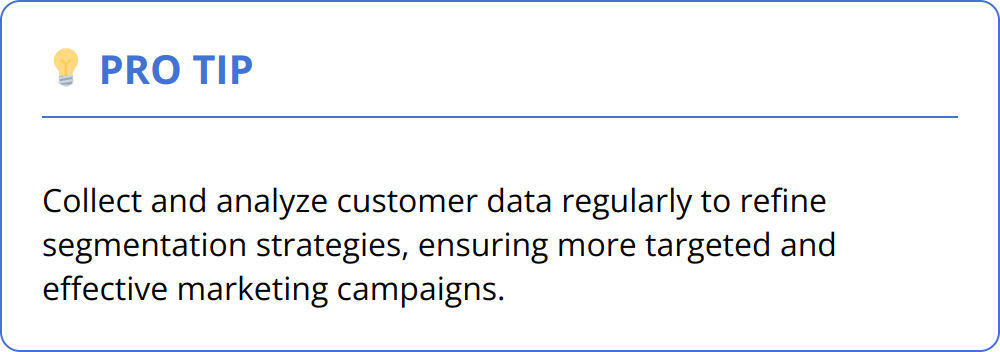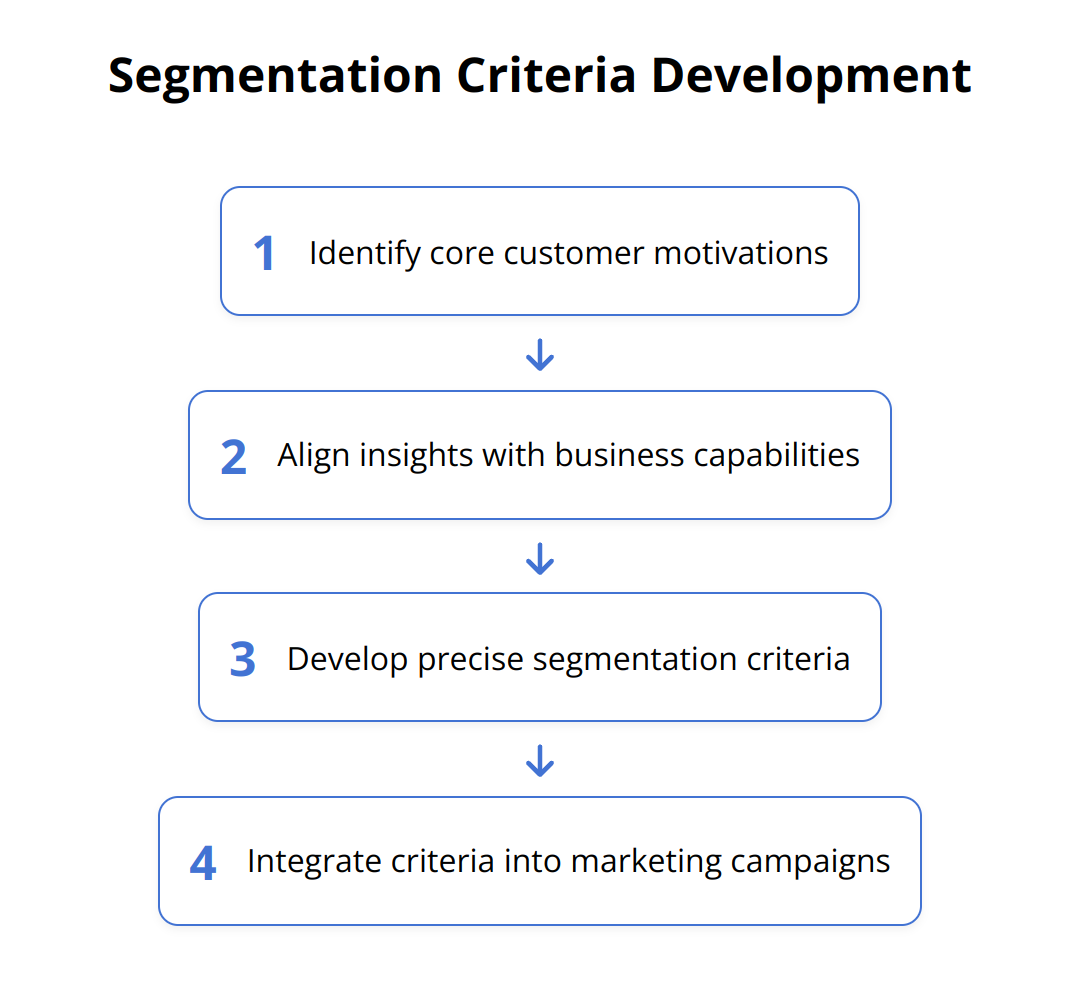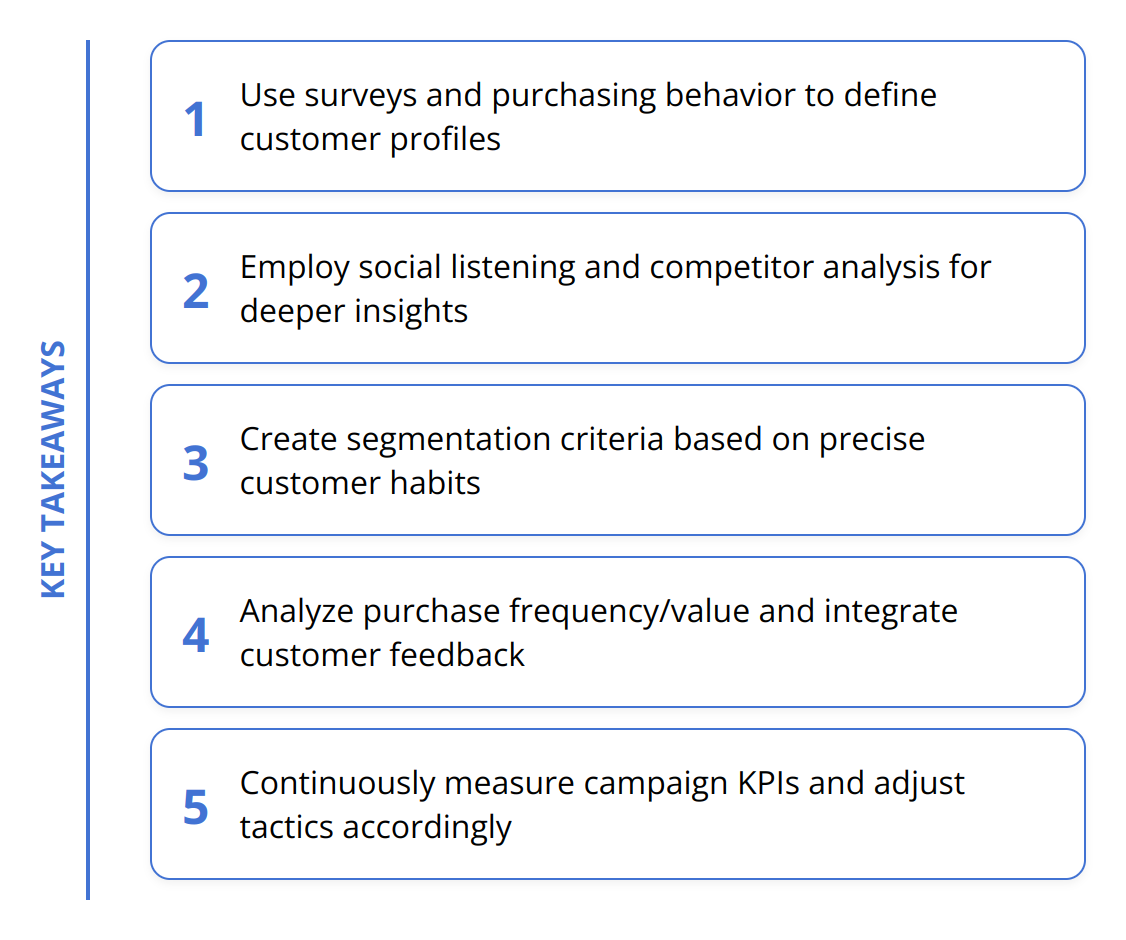We at Emplibot understand that hitting the mark in marketing requires more than just broad strokes; it demands precision. Segmenting your market is akin to sharpening your aim, allowing your message to land with the right audience. By dissecting the process and providing actionable strategies, we aim to help you refine your approach. In the following sections, we’ll lay out the essentials of segmentation and offer insights on implementing these tactics effectively.
Contents
ToggleMastering Market Segmentation
Market segmentation isn’t just a nice-to-have; it’s the backbone of a focused marketing strategy. Diving deeply into segmentation leads to more personalized campaigns, which research has shown can increase revenues up to 15-20% predictive customer segmentation. But what makes market segmentation so powerful?

At its core, market segmentation is about slicing your broad customer base into smaller, more manageable groups with common characteristics. This technique allows businesses to communicate more effectively and allocate marketing resources more efficiently. Instead of casting a wide net and hoping for the best, you’re crafting a tailored message that resonates with a specific audience’s needs and preferences.
One key benefit of market segmentation is that it enables businesses to understand and cater to specific customer desires. You’re not blindly applying the same tactics across the board – instead, you’re addressing real, data-backed trends within your market. For example, a study by Bain & Company indicates that companies that excel in personalization generate more profit, and they achieve this through precise segmentation.
Let’s delve into the primary types of market segmentation:
Demographic Segmentation: Perhaps the most used approach in the segmentation toolbox, demographic segmentation hones in on characteristics such as age, gender, education, occupation, and income.
Psychographic Segmentation: Here’s where buyer psychology enters the fray. Psychographic segmentation focuses on lifestyles, attitudes, values, and personal interests, enabling marketers to connect on a deeper, more emotional level.
Geographic Segmentation: This technique looks at where customers are located, which can be as broad as a country or as narrow as a zip code. Geography often influences buyer habits and preferences significantly.
Behavioral Segmentation: Track and analyze how customers interact with your brand, their purchasing behaviors, and their stage in the buyer’s journey. This type of segmentation can lead to highly effective, behavior-driven marketing initiatives.

For each of these types, the aim is the same: to segment your market in a way that’s measurable, accessible, substantial, and actionable. Agencies and businesses need to ensure they can identify, reach, and pitch to these segments with an offering they are willing to buy.
Here are some practical steps you can take:
-
Collect data through customer surveys and analyze purchasing behavior to outline demographic and psychographic profiles.
-
Use tools like Google Analytics to understand the geographic distribution of your audience.
-
Monitor user interaction with your product or service to pinpoint behavioral patterns that can guide your marketing efforts.
Contrary to a common misconception, market segmentation isn’t just for big players – small businesses can greatly benefit from this approach as well. In fact, it might even be said that for small companies, where resources are more limited, precise segmentation can make or break the marketing strategy.
In the next chapter, we’ll explore the best practices for implementing these segmentation strategies to turn insights into increased customer engagement and revenue.
Shaping Your Market Focus
Building a laser-focused market segmentation strategy is paramount to marketing success. This isn’t just about making lists; it’s about carving a clear path through the complexity of human needs and behaviors to pinpoint where your efforts will bear the most fruit.

Your marketing can truly thrive when you understand who your customers are and what drives them. So let’s look at how to shape your market focus effectively.
The first step is a deep-dive into your target market. Yet, this isn’t merely about demographics. You need to go beyond surface-level data and unearth the motivations behind customer actions. Are they driven by cost, convenience, or lifestyle values? You can’t afford to guess these details. Use a combination of social media listening tools, look at online forums, and examine your competitors’ customers to gather this intelligence.
Once you’ve identified who you’re aiming for, it’s time for the heavy lifting—research and analysis. This step is about connecting the dots between what your customers say they want and what their actions reveal. It’s an exercise in pattern recognition and discernment to predict needs before customers even articulate them. Dive into analytics tools, pull reports, and don’t shy away from the raw data. That’s where the gold nuggets of insights lie.
Creating your segmentation criteria is where these insights crystallize into actionable steps. This isn’t the phase for broad strokes. You need to be surgical. Whether it’s identifying a penchant for eco-friendly products or a trend towards mobile shopping, these criteria are your blueprint for campaign precision.

Don’t spread yourself thin by trying to cover every possible angle. Instead, leverage focused criteria like purchasing habits, content preferences, or even feedback loop data to hone your approach.
Here’s a practical checklist to streamline your segmentation strategy:
-
Evaluate your customer lifecycle, and align your segmentation with where most of your audience is situated in this journey.
-
Look at the frequency and the value of purchases. Are there patterns that predict high-value customers?
-
Feedback is a treasure trove. Analyze customer support tickets, reviews, and product feedback for qualitative insights.
-
Online behavior analytics tools can show you the content that sparks engagement with your audience, offering a window into their interests.
Remember, a strong segmentation strategy is never static; it evolves with your customers. So, keep testing, learning, and refining. With the right focus and a commitment to understanding your audience, segmentation can transform the scattergun approach of yesterday into the sniper rifle of today’s targeted marketing. After all, in a world where attention is the most sought-after currency, ensuring your message hits home is not just beneficial—it’s essential.
Segment-Specific Campaign Execution
Executing marketing campaigns with precision is paramount to achieving high engagement and conversion rates. With a well-defined audience carved into specific segments, it’s time to tailor your marketing messages and choose the most effective channels to reach your target customers. Below are concrete steps to implement segmentation in your marketing efforts, backed by statistics where applicable, and steering clear of nebulous concepts or vague theories.
Craft Compelling Messages That Resonate
Creating messages that resonate begins with a deep understanding of who you’re talking to. A food brand targeting health-conscious consumers aged 18-35 will have to blend striking visuals with content that appeals to their desire for nutritious and convenient meal options. Meanwhile, for professionals over 40, emphasize convenience and time-saving aspects without compromising on taste or nutritional value.
Actionable tips include:
-
Use language that mirrors the segment’s communication style.
-
Reflect their needs in the visuals and narratives of your campaigns.
-
Test different message styles with A/B testing to identify the most effective approach.
Leverage the Right Channels for Engagement
Knowing where your audience spends their time is as crucial as what you tell them. Data from Pew Research Center can guide your decisions on which social platforms cater to which demographics. For instance, Instagram is a powerhouse for reaching younger audiences.

Furthermore, combining social media insights with email segmentation can lead to stellar results. According to Campaign Monitor, marketers see a 760% increase in email revenue from segmented campaigns. Ensure your emails echo the interests of each segment, from subject lines to the body content.
Track and Measure for Ongoing Improvement
Measurement is non-negotiable for any marketer serious about success. Use tools that offer detailed reports on campaign performance across different segments. This could mean integrating a marketing automation tool with your CRM to see how different customer groups respond.
Key performance indicators (KPIs) to track:
-
Click-through rates (CTR)
-
Conversion rates
-
Customer lifetime value (CLV)
-
Retention rates
It’s not enough to just look at the numbers; analyze what they signify about the customer journey and tweak your tactics as needed.
In your pursuit of segmented marketing, keep in mind these essential takeaways:
-
Authenticity and personalization are not just buzzwords but tangible strategies that drive sales.
-
Tailoring content and choosing the right channels must be built on solid data and continuous testing.
-
Measurement and analysis form the foundation for not just proving ROI but also for refining your campaigns.
The subsequent chapter will take these strategies forward, providing more granularity on optimizing each segment’s performance and ROI.
Final Thoughts
The art of segmentation lies in its ability to make marketing messages more relevant and resonant, which is game-changing in today’s competitive landscape. The effectiveness of market segmentation is evident when businesses experience increased engagement and higher conversion rates. By diving into distinctive customer segments, companies can appeal directly to individuals’ interests and needs, establishing stronger connections and loyalty.

It is important to recognize that market segmentation is a dynamic process. Refining segmentation strategies is key to keeping pace with changing customer behaviors and market conditions. Regularly revisiting your segmentation framework allows your marketing strategies to remain efficient and effective, ensuring that engagement continues to grow.
Looking to the future, there are several trends that marketers should keep an eye on:
-
Personalization will deepen as marketers leverage data to tailor experiences further.
-
Improved predictive analytics will enable anticipation of customer needs.
-
The use of artificial intelligence in segmenting markets will expand, becoming ever more sophisticated.
As strategies become more refined, the process can become complex. However, with the advent of powerful tools like Emplibot, efficiency in creating SEO-friendly content becomes streamlined. By automating the process of publishing articles on WordPress, including research and even image selection, Emplibot makes regular content updates hassle-free.
For those with a keen interest in efficiency and targeting, engaging content is a must. Emplibot supports businesses by ensuring their blog remains active and appealing to distinct market segments.
In summary, market segmentation isn’t a one-and-done task; it’s a continuous, iterative process that aligns closely with the evolutionary nature of markets and consumer preferences. In employing these strategies, businesses can achieve:
-
Enhanced customer engagement through personalized experiences.
-
Higher conversion rates by reaching the right audience with pinpoint accuracy.
-
Increased revenue by focusing on high-value customer segments.
To navigate the complexities of market segmentation and personalized marketing with greater ease, it’s vital for businesses to employ tools that save time and enhance effectiveness. Emplibot can be your ally in this journey, enabling you to stay on top of content demands while focusing on your refined market segmentation strategy. Visit Emplibot to explore how automated content creation can support your marketing endeavors.
By embracing the continuous process of revising and optimizing market segmentation, businesses set themselves up for success. The future is bright for those who grasp the power of personalization and its impact on market segmentation. With the right tools and strategies, targeting audiences is becoming more efficient, transforming the marketing landscape one segment at a time.











